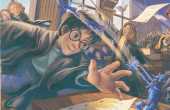Sarah
Sarah loves to read, believing in books there is magic. She likes to think she’s witty. (She is not witty.) Sarah likes many thing—except for vegetables.
Junior Contributor II
- Articles
1 - Featured
0 - Comments
3
- Ext. Comments
3 - Processed
0 - Revisions
0
- Topics
1 - Topics Taken
1 - Notes
2
- Topics Proc.
1 - Topics Rev.
1
- Points
156 - Rank
X - Score
69
Latest Articles
Latest Topics
Published | Young Adult Literature: The EscapeWhat is it about YAL that makes the genre so popular. Despite its name and set ‘age range’ young adult books are making waves and gathering attention to those of many ages allowing us to escape into the words created. Is it simply because we find the characters, situations, or world relatable? Are we living vicariously through the lives of characters we wish we could have been or been? What is it about YAL that is so captivating? Don’t believe me? Just look at all the book to screen adaptations chosen to live on the big screen. How do you Escape into the fantasy world of dystopian or YAL. Young adults and teens alike choose to lose themselves in the words living and learning vicariously through the characters.
|
Latest Comments
| The Rising Popularity of Dystopian Literature | |
In both, male or female characters there’s always going to be an element of sexuality present in their costumes. The article on Radiotimes.com pointed light on the fact that Male costumes always seem designed to emphasize his power and strength. Often choosing to show off the hero’s oversized biceps (like with Thor), or going so far as adding precisely placed padding to accentuate a set of killer abs. Female costumes, on the other hand, are often designed to emphasize sexuality. Typically only covering the bare minimum (her lady parts) but leaving substantial amounts of bare skin, including large breast, a slim stomach, and long legs. | Female Superhero Representation in Comics |
I love this article for three reasons. One, because HELLO who doesn’t love J.R.R. Tolkien and the world of Middle Earth. Two, because this article was your ordinary take on ‘routing for the underdog. And three, because I felt like Parshall was passionate on her take of hobbits, her options were both emotional and informational since she backed her claims with cited quote sand tidbits from Tolkien’s, Lord of the Rings series and The Hobbit. I agree with her wholeheartedly that most readers seem to take the true essence of a hobbit for granted. She states early on that “Hobbits enjoy nothing quite as well as they do the comforts of their home: they love naught more than the camaraderie of good food, beer, and pipeweed. Hobbits do not like change and do not know much of the world outside the borders of the Shire” (Parshall). It is this that makes a hobbit such as Bilbo, Frodo, Samwise, Pippen, Merry such remarkable creatures. The Fellowships journeys failures and victories so not break their spirit but rather gives them to the courage to overcome the most trying of perils. “The hobbits arise from relatively nothing legendary to make themselves into heroes despite dear and unreasonable odds, and it is this destruction of their innocence that becomes so relatable. They show the full trajectory of what courage means. Starting from a place of innocent fear, acknowledging the fear and its limitations, and them harnessing those fear to do what must be done for the greater good” (Parshall). The smallest most peaceful of Middle Earths creatures have the biggest transformation. Though naïve to the dangers surrounding them, at first anyways, their heart and resilience win out. Combined with the loyalty of and to their companions, they are able to take on great responsible in the face of death and destruction effectively earning the heroic title. | Hobbits: Tolkien's Unlikely Heroes |

Dystopian worlds or societies are more fantasy than reality. Trilogies such as The Hunger Games, Catching Fire, and Mockingjay by Suzanne Collins, Matched, Crossed and Reached by Ally Condie, and Divergent, Insurgent, and Allegiant by Veronica Roth are all good examples of “the idea that human nature, rather than nurture, determines how we act and live. Each trilogy has a character that has a lot of obstacles to overcome, not just physically but mentally as well. They have to make unique decisions that typically conflict their societies leaders, an example of individual freedom rather than conforming to society pressures. Even though these novels may be solely based on fantasy, the issues of peer pressure from society are very real; yet another reason why young adults can relate to the fictional characters present in the dystopian world. No matter the setting, YA characters tend to develop emotionally as we the readers turn the page, an emotional journey to find themselves.